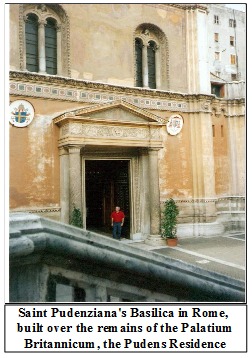Latest Posts
View the latest posts in an easy-to-read list format, with filtering options.

Volume 1. This gives a short history of the Church from the apostles to the Roman War, including Luke’s account of Paul’s journeys in the book of Acts. It includes Paul’s fourth missionary journey to Spain and Britain.
Category - History and Prophecy

I showed in Chapter 20 how the grain ship from Alexandria was prophetic of Pentecost or the Pentecostal Age. I also mentioned how the pilot and captain of the grain ship represent the denominational church leadership.
By extension, the sailors tending the ship would also represent the Church in some way, whether leaders or lay people. Keep in mind also that they were taking the wheat to Rome, which at that time was the fourth kingdom of Daniel's prophecies and the inheritors of the Babylonian succession of empires. This may foreshadow the “move” of the Church to Roman domination that would come in later centuries.
The hurricane represents tribulation, much like it does in the story of the disciples in the storm on the Sea of Galilee in John 6, where Jesus came to them in the midst of the lake. In both cases, those representing the Church are going through tribulation. In the middle of the “lake” (tribulation), Jesus arrived and transported them to the other shore. John 6, of course, portrays the feast of Tabernacles, as I have explained more fully in my book, The Laws of the Second Coming. We read in John 7:14 that Jesus appeared in the middle of the feast of Tabernacles, even as Jesus came to His disciples in the middle of the lake (tribulation).
But here in Acts 27:38, the wheat is (literally) “cast out” into the sea on the second day of the storm (vs. 18). This hardly represents a “rapture” in the sense that much of the Church currently teaches. It is more reasonable to say that tribulation will cause the wheat company (believers) to leave the denominational church systems (the ship). An alternative view is that the believers are forced to give up their Pentecostal limitations and see the greater vision of Tabernacles.
After 14 days of tribulation, as the ship approached the island just after midnight, it must have been a very frightening time. It was very dark except for a few ship lanterns that would hardly remain lit in the high winds. But they knew they were approaching the rocky shore of an island where the ship would certainly be destroyed.
So the sailors decided to get into the life boat, on the pretext that they were going to put down some anchors. It seems to me that this speaks of the Christians’ belief in the rapture, that somehow they will leave the earth before the tribulation arrives. But Paul prophesied in verse 31, “Unless these men remain in the ship, you yourselves cannot be saved.”
So the soldiers cut the ropes, and to the horror of the sailors, the life boat fell into the sea. Prophetically speaking, this tells us that it is necessary that the Christians remain on earth in the tribulation in order to bring about the salvation of the “Romans” (i.e., the world). Christians would like to escape and leave the rest of the world to suffer under the dominion of the devil or the Antichrist. But God is interested in saving the world.
And sure enough, all 276 souls aboard the ship were “saved thoroughly” (diasozo). Not one was lost in the end. That is the divine purpose given in this parable of Acts 27. This took place after 14 days, because 14 is the number of release or deliverance. (See my book, The Biblical Meaning of Numbers.)
After they arrived safely on land, they built a fire to warm themselves, and that is when Paul encountered a serpent, which bit him. The people of the island who witnessed this event thought at first that Paul must have been a murderer and that justice had been meted to him by divine justice. But when Paul did not die, they began to think he was a god (28:6).
The people of Malta, or Melita, were Phoenicians who did not speak Greek, so they were called “barbarians” in 28:2. This did not mean that they were uncivilized, but simply spoke a different language. Malta is located just south of Sicily, and in the Roman Empire, the leader of Malta was under the jurisdiction of the Roman Praetor of Sicily.
This leader's name was Publius. He treated the castaways kindly. The father of Publius, however, was sick with dysentery (NASB), so Paul laid hands on him and the man was healed. This started a larger rush of people, who came to Paul for healing, and Acts 28:9 says that they were healed as well. Does this not speak prophetically of the conditions following the serpent's fall into the “lake of fire,” when the Tree of Life is given for the healing of the nations? (Rev. 22:2)
The castaways remained in Malta for three months from November to February. It happened that another Alexandrian ship was wintering in Malta. When it departed for Sicily, Paul and the Roman soldiers boarded the ship and sailed for Syracuse (on Sicily). No doubt Paul found other believers there, for in 40 A.D. Peter had sent St. Pancras and Martian to Sicily as missionaries. Martian is today remembered in Syracuse, for he was martyred by the Jews there.
After staying just three days in Syracuse, they went to Rhegium (now Reggio) and then to Puteoli on the Bay of Naples. For some reason Julius the centurion allowed Paul to fellowship with the believers there for a full week (28:14). When the brethren from Rome heard of their landing in Italy just south of Rome, they came as well to meet them at “the Appii forum and the Three Taverns” (28:16).
This is one of five times in the New Testament where the Greek word apantesis is used, translated “to meet.” It has to do with going out to meet a visiting dignitary for the purpose of escorting him back to town. Today we would call it “rolling out the red carpet.” This is the term used also in Matt. 25:1 and 6, where the bridesmaids were told, “Go ye out to meet Him.”
The same term is used in 1 Thess. 4:17, the well-known “rapture” verse, which says that the believers will be caught up “to meet the Lord in the air.” The purpose of this catching up is to meet Christ and escort Him back to earth—not to return to heaven with Him. We are meeting Him as He comes to earth. He is not meeting us on our way to heaven. I have explained this more thoroughly in my book, The Rapture in the Light of Tabernacles.
Interestingly enough, Paul”s friends from Rome (probably Rufus Pudens and Linus, among others) came to meet Paul at the Three Taverns (taberne). This is actually from the Latin word, TABERNA, and seems to me to be a veiled prophetic reference to the Feast of Tabernacles, during which time we are to go out to meet Him and escort Him to earth.
When the band arrived in Rome, the prisoners were delivered to the captain of the guard in Rome, but Julius allowed Paul to remain free except for a guard that accompanied him at all times. There is no doubt that by this time Julius was a believer, as well as the soldier guarding Paul daily.
After three days Paul called the Jewish leadership to meet with him, so that he could explain to them why he was in Rome. The leaders had heard of this new “Way” and only knew that other Jewish leaders had opposed it. Paul then explained how Jesus Christ had come to fulfill the prophecies of “the hope of Israel” (28:20). Some of them believed, but most of them did not. (28:24). And so, Paul told them that Isaiah 6:9, 10 was being fulfilled. Just as significant, however, was Paul's addendum in verse 28,
{Acts 28:28} {Acts 28:28} 28 Let it be known to you therefore, that this salvation of God has been sent to the Gentiles [ethnos, “nations”]; they will also listen.
Paul then spent two years in Rome under guard, no doubt living in the Palatium Britannicum, the house of Rufus Pudens and Claudia, where also he was able to see his mother. Here Luke’s  account seems to come to an end, though it is universally acknowledged that its ending is abrupt as if the book in its present form is incomplete. It ends this way:
account seems to come to an end, though it is universally acknowledged that its ending is abrupt as if the book in its present form is incomplete. It ends this way:
{Acts 28:30} {Acts 28:30} 30 And he stayed two full years in his own rented quar-ters, and was welcoming all who came to him, {Acts 28:31} {Acts 28:31} 31 preaching the kingdom of God and teaching concerning the Lord Jesus Christ with all openness, unhindered.
But early Church history also shows that Paul was not executed at his first appearance before Nero. Instead, Paul seems to have disappeared from view, only to appear a second time before Nero, at which time he was beheaded as a convicted Roman citizen.
The history of Paul seems to continue, however, with the 29th chapter of Acts found in the so-called Sonnini Manuscript, which I have reproduced in full in the first Appendix.